
E
thiopia is part of the Horn of Africa, it is the oldest African independent country and it is 4.6 times larger than the UK . It covers 1.13 million Km², and has the second largest population of any African country.
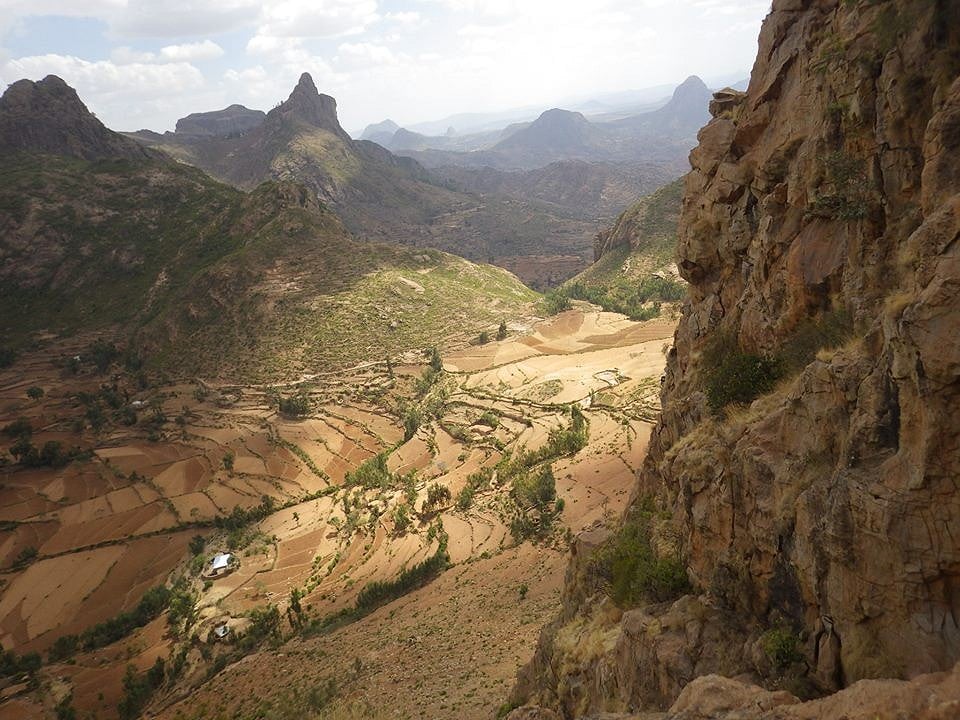
Ethiopia is a country of extremes, with the fertile Omo Valley in the South, which has an average annual rainfall of 1134mm, (the Uk's 2013 average annual rainfall was 1091mm). The Danakil Depression in the North is –125m below sea level and one of the hottest places on earth, while Ras Dashen (the highest mountain in Ethiopia), is 4550m above sea level (just 260m below Mont Blanc).
Addis Ababa, the capital is abuzz with new investment, expensive hotels and lots of foreign workers, while the rural villagers tend to be poor subsistence farmers. The average male life expectancy is 58 years of age.
The national food (eaten daily by most Ethiopians) is Injera, and it's Ethiopia's answer to marmite: tourists (known locally as Farenji) either love it or hate it! At times, members of the Ethiopia Rocks team could be overheard comparing it to sour carpet underlay, I however, quite liked it!
In the past 10 years there has been an increase in the number of Ethiopian based rock climbers, and a growing number of climbing and bouldering expeditions to Ethiopia by British, American, French, Swedish, and Spanish teams. As a result many new routes and boulder problems are being put up all over Ethiopia each year. Despite much hard work and effort by a few dedicated climbers, the amount of information available about Ethiopian climbing on the internet is still very time consuming to research.
The Ethiopia Rocks 2014 Team decided to head to Ethiopia because it has endless adventurous rock climbing, in the sun, with new routes at a large variety of grades, in a country full of culture.
When researching the trip, the limited availability of Ethiopia rock climbing information prompted us to put together a very basic, but up to date guidebook to Ethiopian rock climbing. We hope a guidebook might encourage more climbers to visit Ethiopia, which in turn, could create a much needed income for villages near the climbing areas but away from the main tourist sites.

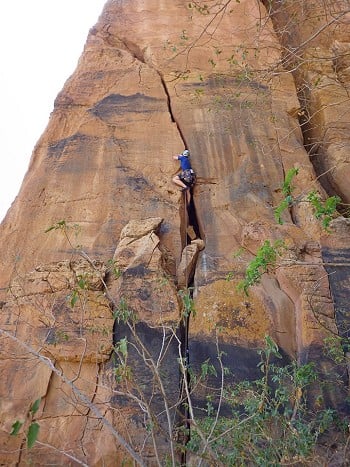
The views out of the truck morphed from a bustling city full of people stocking up on supplies ready for an Easter Sunday feast, to countryside views of rolling hills, valleys and jagged mountains and escarpments. The shops turned to green pastures and forests, which in turn changed to dustier, dry and rocky ploughed fields. Wherever in the country we were, and however quiet the roads, the locals were consistent in their approach to crossing roads. They would wait until the car was just meters way, and then dart out infront of us, and if they did not, their livestock would!
Many mud tracks have recently been upgraded to asphalt roads, but the increase in traffic has not decreased the local children's enthusiastic waving as vehicles pass. The novelty of this increased speed was all to apparent by the regular wreckage of lorries that had plunged off roads down the steep mountain sides, or whose brakes had failed just before a tight switch back.
For as far as the eye can see there are round mud huts and herds of sheep. Goats and oxen are being herded by children with impeccable aim, throwing just one rock at goat to alter the whole herds direction. Orthodox churches can be seen dotted all over the landscape and on most high points and rocky outcrops, and on the East side of the country mosques make regular appearances too. We soon discover that these are keen to wake you up bright and early most mornings, either with the Muslim call to prayer, or regular Ethiopian Orthodox Christian Saint days.
There is rock everywhere in Ethiopia, but previous expeditions have mainly visited the Adwa and Gheralta regions in Northern Ethiopia, and the Bale mountains in Southern Ethiopia. Despite being keen to venture South, our trip coincided with the start of the rainy season in Bale, so this dictated that we head North.
We spent our first week camped just outside the town of Adwa in a small village called Girima. Abraham our driver translated, and helped us negotiate with the village elders, who's permission we needed to camp and climb in the valley. We were asked to set up camp in the village center and were soon surrounded by local children intrigued to see what the farenji were doing.
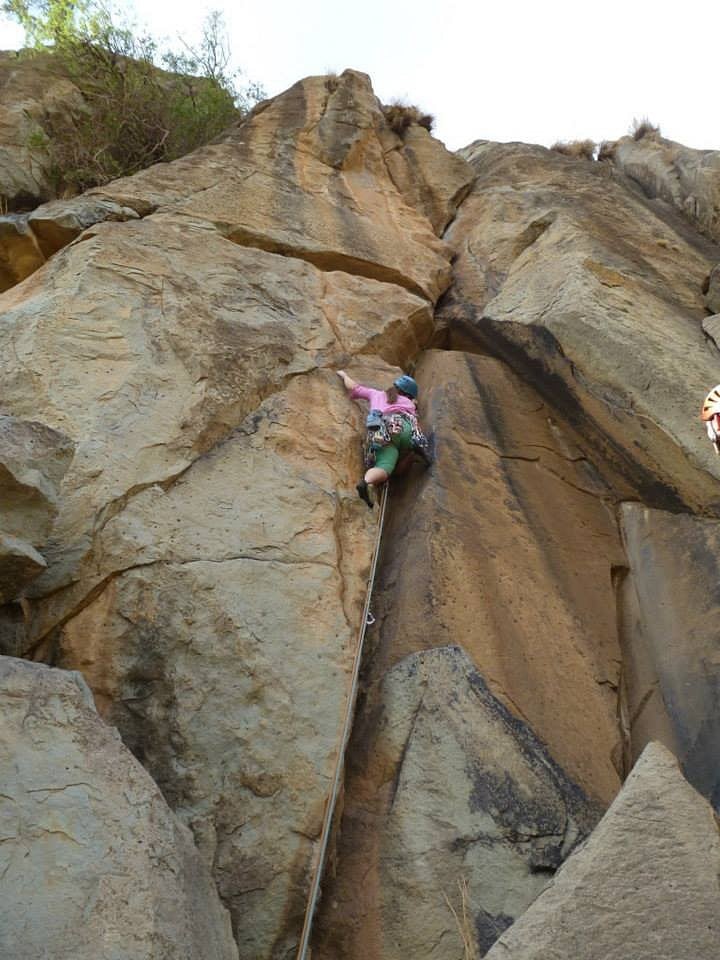
The rock in Adwa is igneous, and is generally pretty solid, with spaced gear and some vegetation. The rock climbing comes in all grades, from endless trekking and peak bagging, scrambling, and ridge traverses (alpine-style), to hard sports routes, trad routes, new routing and bouldering. We spent a week exploring rock climbs on the surrounding crags, sending our keen fell runners off for afternoon recces to scope out the potential in rock faces on the horizon. We were able to climb everyday, and lost only one day to exploration, (where undergrowth on the approach to the crag got the better of us). The midday sun in Adwa was often too hot to climb in, unless you found a shady crag, but a thin fleece or windproof were necessary most early mornings and evenings, and in the shade. We were lucky, because Paramo were keen to help promote sustainable tourism in Ethiopia, and kindly sponsored us with some Paramo high activity fleeces and windproofs, which were the perfect additional layers.
We wanted the locals to see the potential benefits of tourism to their small community, so while in Girima we tried to buy basic supplies such as bread and beer. We also made sure to tip the locals where appropriate, like the local lady who took it upon herself to guard out tents each day, and to leave a donation for community projects with the village elders.
We spent our second week in Yeha, and its proximity to the Eritrean border meant the village elders were keen to keep a close eye on us to ensure our safety, and insisted we camp next to the archeological dig site in the center of the village. The locals were so intrigued with our bouldering escapades, that the local boys joined in, still wearing their jelly shoes, and did themselves proud.
Yeha is filled with a lot of solid rock, which in the main, you could walk off of, and lots of really friendly locals. One conversation being particularly memorable, without a common word between us, we managed to translate the emotion-filled gestures of a local gentleman, as a warning there were falling rocks. We assumed these were dropped by the larger than life vultures, but half way up 'through the eye of a needle,' Tom looked down to see monkeys running across the lower ledges instead, and so somewhat belated and already committed, we came to realize the significance of the local man's gestures! Yeha definitely came with added wildlife, including: geckos, snakes, monkeys and lizards, but in its credit, it seemed to have fewer scorpions than Adwa! The snake skin trailed along the pockets of the roof to the belay on 'touching the snake' definitely made me climb quicker, choosing to use crimps on the outside of the chimney pitch rather than thrutch in to its depths!
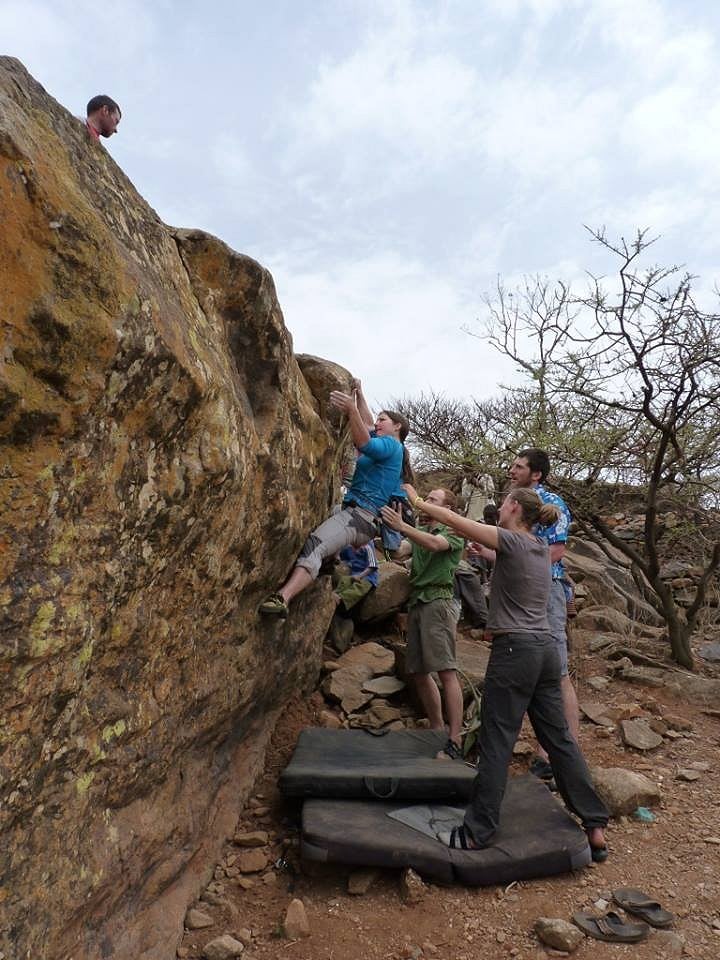
Our final week was spent in a local guest house in Hawzien, in the sandstone tower filled Gheralta region. We found a crack, off width, chimney and esoterica loving climbers paradise. Every route that looked viable from the road with a pair of binoculars, proved to be much wider than anticipated when stood below it. The rock quality varied, the gear was an endless supply of massive cams, and the scenery was amazing, with an almost an endless vista of sandstone towers. There's a multitude of amazing rock hewn churches in Tigray, with one of the most famous being Abune Yemata Guh, and as a result, the locals are much more used to farengi. As off-widths were not our specialty, the Gheralta region involved the highest number of unsuccessful bush-caving-rack-treks (where we walked most of the day with a full trad rack in our rucksack, through lots of goat shaped passageways in the bushes, and didn't do much climbing!) There is also an amazing train of granite boulders running down the valley, and these was a great place to spend late afternoon and evenings. Before returning to Addis Ababa, we were treated to a coffee ceremony at the guest house, where we bid farewell to the lovely ladies who ran it, and left with them lots of useful items we had bought and no longer needed.
We consider our expedition to have been a great success, we climbed lots of new routes, had a great time, put together a guidebook to help future climbers, and are all keen to return to Ethiopia some day.
If you want to get in contact with us for more information about Ethiopian rock climbing or are interested in seeing more photos then check out our facebook page.
VIDEO: Ethiopia Rocks 2014
Logistics
When to Go
The rainy season in Ethiopia is the start of June to start of October (although the rainy season is shorter in Tigray). Therefore, mid October to Mid May are the best times to visit Ethiopia to go climbing.
How to Get There
Fly to Addis Ababa and then either get internal flights (which are cheaper to book in-country than on the internet) to Aksum in the North, and then hire vehicle and driver from there, or miss out the internal flights and hire a vehicle and driver from Addis, to drive up to the North, or South to the Bale Mountains. As a foreigner you will not be able to self drive a hire car in Ethiopia. For a landcruiser (we had 7 people in it), driver and fuel we paid $150 per day.
Accommodation Advertise here
No Premier Listings found in this area
In Addis Ababa there are all varieties and costs of hotels, we were paying $40 per night for double/twin beds in massive bedrooms with fridges, sofas and dinning room tables and private bathrooms.
There are small very basic (and normally not very clean) hotels/guest houses in most towns, but out in the villages, we found the best course of action was to ask permission to camp from the village elders, and agree a cost beforehand or leave a tip for the community afterwards (if they didn't ask for any payment).
Gear
There are no climbing (or camping) shops in Ethiopia, so you must take everything you might need to be self-sufficient with climbing and camping kit. We took double ropes, full trad racks with double cams, nuts etc, some gear behind if necessary and lots of tat. You will need to take a fuel stove with you, as you may not be able to buy gas canisters in Addis, and a steri pen (with plenty of batteries) and iodine are good ways to sterilise the local water supplies. Make sure to buy some buckets and jeri cans to fill with water if camping/in small towns, as water is often only available for a hour or 2 in the morning and evening, and so you need to store it. Take all of the sun tan lotion and mosquito repellent (DEET) that you will need for the trip. Where possible, it is best to take out biodegradable washing up liquid, clothes wash and shampoo if camping as you will be washing straight into yours and the villages precious water supply.
We bought plates, pots, pans, washing up bowls etc in the supermarkets in Addis Ababa on out arrival, but it should be noted that things like cutlery are expensive to buy as the locals do not use it themselves.
Temperature-wise, it is cool at night and very hot in the day. The local culture dictates that men/women should not show their shoulders, so cool shirts, long shorts and sun hats work well in the day and fleeces and windproofs work well in the evenings and early mornings. We needed a waterproof once, and windproofs proved man enough for the wet walk back to camp. Shoes and sandals worked well (we took walking boots but didn't feel the need for them. We mainly had 3 season sleeping bags and this seemed to work well with a liner (as you were constantly lagged in dust). Binoculars were useful for spying new lines.
Guidebooks
There is a basic guidebook produced by us, it is worth printing it out and taking that with you. FIND IT HERE
There are maps available in country, but on of our team looked at googlemaps/google earth in the UK before heading out, and cached all of the maps on his tablet and we referred to this to find crags. In the larger hotels there is often electricity and wifi (when working) and so we could charge things up and look up more information.
- We also have a Full Expedition Report Online Here
Instructor/Guides Advertise here
No Premier Listings found in this area
Food and Supplies
As we were camping we bought western style food (pasta, rice, tinned tomatoes) in Addis Ababa, and then stocked up on fresh fruit and veg, bread, and dried pulses near where we camped. A little planning is required and often there is little variety: tomatoes, chillies, onions, cabbage, carrots were the staples.
Most towns will have a small restaurant serving local food (maybe only a few choices), often you may only be able to buy fasting (meat-free food) depending on the day of the week. In larger towns you may also be able to buy western food in restaurants, although be warned that the diverse menus often don't portray what is actually available on any particular day!
Other Activities
The list is endless, there are monolithic rock-hewn churches in Lalibela), indigenous tribes in the Omo Valley, The UNESCO World Heritage Site of the Simien Mountains, Aksumite Empire ruins in Aksum, Lake Tana and Bahar Dar, and abundant wildlife.

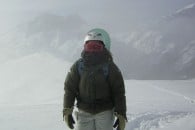










Comments